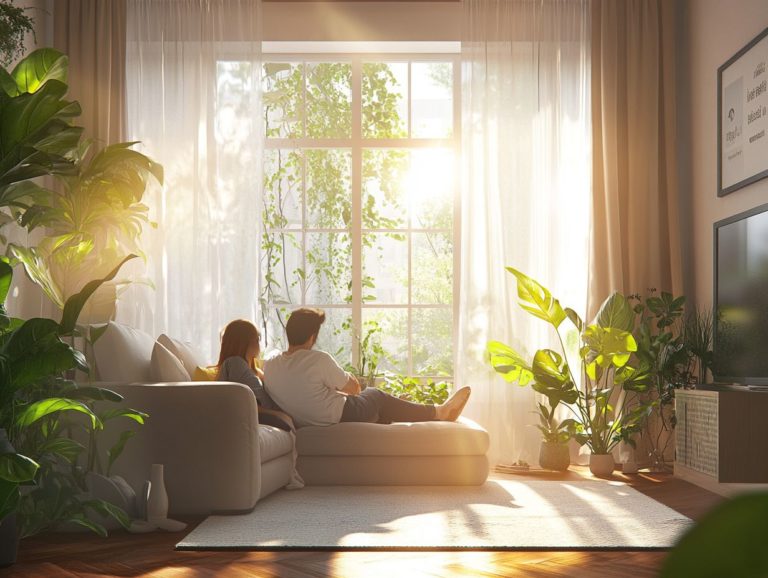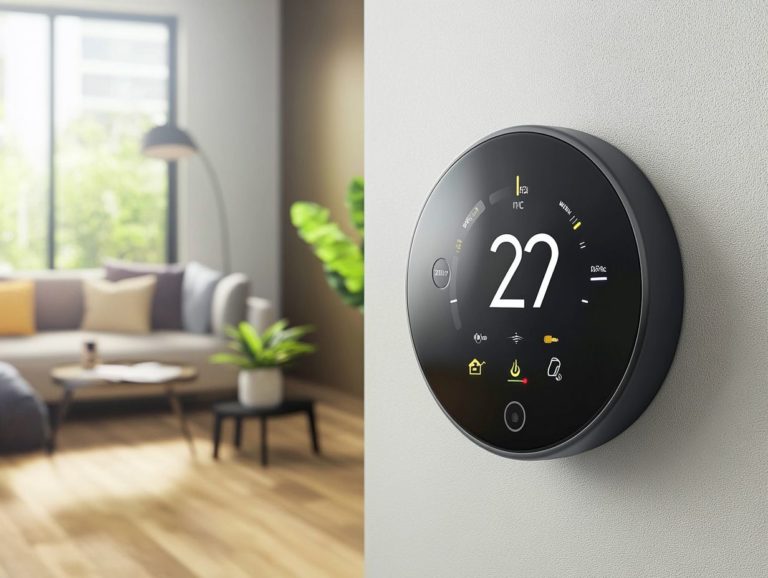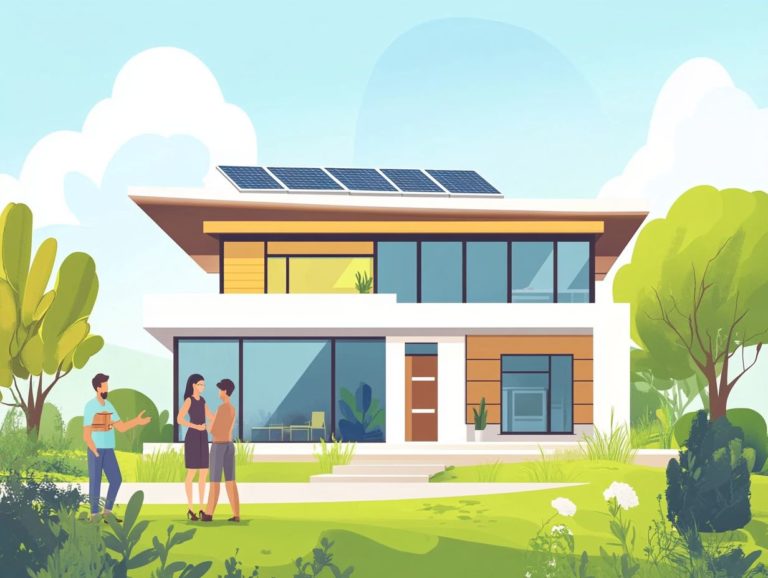How Can I Make My Home Sustainable?
Sustainability transcends mere buzzwords; it embodies a vital approach to living responsibly in today s world.
This exploration delves into the essence of sustainability and its significance, particularly within the context of your home. From reducing energy consumption and conserving water to choosing sustainable materials, you’ll find practical ways to transform your living space into an eco-friendlier haven.
We will unpack the benefits of a sustainable home, identify the challenges you may encounter, and provide you with tips to embark on your journey toward a greener lifestyle. Small changes can create a big impact!
Contents
- Key Takeaways:
- Understanding Sustainability
- Ways to Make Your Home More Sustainable
- Benefits of a Sustainable Home
- Challenges and Solutions
- Getting Started with Sustainable Living and Energy Efficiency
- Frequently Asked Questions
- 1. How Can I Make My Home Sustainable and Energy Efficient?
- 2. What Are Some Eco-Friendly Materials I Can Use in My Home?
- 3. Are There Any Government Incentives for Making My Home Sustainable?
- 4. How Can I Reduce Waste in My Home?
- 5. Can I Make My Home Sustainable on a Budget?
- 6. Why Is Sustainable Living Important?
Key Takeaways:

Here are some practical tips to get you started:
- Reduce energy consumption by investing in energy-efficient appliances, turning off lights and electronics when not in use, and using natural lighting whenever possible.
- Conserve water by fixing leaks, installing low-flow fixtures, and using drought-resistant landscaping.
- Choose sustainable materials for home renovations and upgrades, such as recycled or renewable materials, to reduce environmental impact and promote a healthier home.
Understanding Sustainability
Let s explore what sustainability means and why it matters. Understanding sustainability is crucial for you to create a healthier environment and pave the way for a sustainable future for generations to come. It involves a wide array of practices and principles aimed at reducing your impact on the environment while enhancing social well-being and ensuring economic viability.
By prioritizing energy efficiency and utilizing renewable energy sources, such as solar power and eco-friendly materials, you can make significant strides toward sustainability. If you’re wondering how to make your home more energy efficient, adopting sustainable practices in urban areas like California and New York City can help mitigate the adverse effects of climate change and foster a more resilient society.
Organizations such as the EPA and NRDC, along with esteemed academic institutions like Columbia University and the City University of New York, play vital roles in advocating for and implementing sustainability initiatives that you can engage with and support.
Defining Sustainability and its Importance
Sustainability is all about meeting your needs today without jeopardizing the ability of future generations to meet theirs, especially in terms of energy efficiency and eco-friendly design.
This concept typically unfolds through three interconnected areas: protecting the environment, supporting communities, and managing resources wisely. The environmental aspect emphasizes the importance of reducing waste and conserving natural resources, while social sustainability champions community well-being and equality. Economic sustainability focuses on the responsible management of resources, ensuring long-term financial stability.
For example, sustainable homes equipped with solar panels and energy-efficient appliances not only cut your utility bills but also contribute to lower greenhouse gas emissions. These homes are vital in the fight against climate change, promoting a lifestyle that respects ecological balance and nurtures a healthier planet for those who come after us. Understanding what is sustainable home energy can further enhance the benefits of such homes.
Ways to Make Your Home More Sustainable
Transforming your home into a sustainable haven requires a thoughtful blend of strategies that prioritize energy efficiency, eco-friendly practices, and water conservation.
By incorporating solar energy through photovoltaic panels, you can significantly lessen your dependence on fossil fuels. The use of sustainable materials enhances both the functionality and aesthetic appeal of your space, contributing to overall environmental conservation efforts. To further optimize your home, consider exploring how to create a smart energy-efficient home.
Even simple changes, like installing energy-efficient appliances and implementing a grey water system a system that recycles water from sinks and showers for use in toilets or gardens can markedly diminish your home’s environmental impact.
Start your journey toward a more sustainable home today!
Reducing Energy Consumption
Reducing energy consumption in your home starts with understanding how energy is used. Discover ways to optimize efficiency through smart appliances and advanced technologies.
One effective strategy is to invest in Energy Star appliances. These are designed to use less energy without sacrificing performance. Not only do these appliances lower your energy bills, but they also help reduce your environmental footprint.
Adding smart thermostats to your home can significantly enhance your energy management. They allow you to set heating and cooling schedules that fit your lifestyle, preventing waste in unoccupied spaces.
Exploring solar energy solutions can further decrease your reliance on fossil fuels. Choosing the right insulation helps keep your home comfortable year-round. Additionally, following these 5 tips for creating a sustainable energy home is crucial for viewing renewable energy sources as essential to an energy-efficient home.
Conserving Water

Water conservation is vital for sustainable living. It not only helps preserve a precious resource but also lowers your utility costs and minimizes your environmental footprint.
To achieve effective water savings, you can use practical methods. For instance, installing low-flow fixtures in your kitchen and bathroom can significantly reduce water usage without losing performance.
Implementing a grey water system allows you to recycle water from baths, sinks, and washing machines for irrigation, enhancing conservation efforts. Opting for dual flush toilets helps you manage water waste efficiently by providing different flush options.
Additionally, focusing on water-efficient landscaping like planting drought-resistant plants greatly minimizes the need for excessive watering, contributing to a more sustainable environment overall.
Using Sustainable Materials
Using sustainable materials in your home enhances aesthetics while supporting environmental conservation. This minimizes reliance on non-renewable resources.
By choosing materials like reclaimed wood, recycled metal, and natural insulation, you can significantly lower your carbon footprint while creating inviting spaces. Additionally, creating a sustainable home with energy storage can enhance your efficiency. Practices like composting organic waste contribute to healthier living environments and turn waste into valuable resources for your gardens.
Sourcing materials responsibly whether from local suppliers or certified eco-friendly manufacturers supports community growth and cuts down on transportation energy. These strategies transform construction and renovation into processes that prioritize both your well-being and the planet’s health.
Benefits of a Sustainable Home
A sustainable home offers numerous benefits, from reducing your environmental footprint to achieving significant financial savings in the long run. By integrating energy-efficient technologies and renewable energy systems, such as solar panels, you can greatly lower your utility bills while boosting overall comfort.
By emphasizing eco-friendly design and using smart thermostats, you can create a living space that is sustainable and cost-effective.
Environmental Impact
The environmental impact of a sustainable home is impressive. By reducing greenhouse gas emissions and decreasing reliance on fossil fuels, you actively support renewable energy sources.
This transition improves air quality by lowering pollutants and encourages biodiversity through eco-friendly habitats. Choosing energy-efficient appliances and sustainable materials plays a vital role in conserving essential resources and mitigating environmental damage.
Sustainable homes dramatically lower your carbon footprint, contributing significantly to the fight against climate change. These practices create healthier living environments that your family will love and inspire your community to adopt eco-conscious behaviors, paving the way for a more resilient planet.
Start your journey to a sustainable home today!
Financial Savings
Financial savings serve as a compelling incentive for you to invest in a sustainable home. By opting for energy-efficient appliances, you can enjoy lower utility expenses and long-term cost reductions.
As a homeowner, you may discover that integrating green technologies, like solar panels or smart thermostats, can lead to significant decreases in your energy bills. If you’re interested in taking this further, learning how to integrate renewable energy into homes could provide you with valuable insights. Beyond the immediate financial relief, you could also take advantage of various tax incentives designed to promote eco-friendly living, making those initial investments much more attractive.
Over time, homes built with sustainability in mind generally appreciate in value, catching the eye of future buyers who prioritize eco-friendly choices. This commitment not only contributes to a healthier planet but also bolsters your financial stability in the long run. To get started, consider exploring DIY sustainable home practices you can implement today.
Challenges and Solutions

Transitioning to a sustainable home may come with its fair share of challenges, including initial costs and technological hurdles. However, countless solutions are available to smooth this journey, ultimately leading to long-term benefits that are well worth the effort.
Overcoming Obstacles to Sustainability and Conservation
To overcome obstacles to sustainability, you need to understand the challenges at hand and take a proactive approach to implementing effective solutions and energy sources that can be replenished, like solar and wind.
You may find that financial constraints and fossil fuels often act as formidable barriers, making it tough for you and your community to adopt sustainable practices and water conservation. The lack of information about available resources can leave you feeling overwhelmed by the abundance of information available about eco-friendly practices and renewable power and uninformed about the importance of energy efficiency and the role of sustainable materials.
To navigate these hurdles, join local programs today, such as community workshops focused on budgeting for green upgrades, including solar panels and energy-efficient appliances, or organizations like the Sustainable Community Network and Sunrun that promote solar energy. These groups offer invaluable support. By leveraging these resources, you can discover cost-effective strategies, rebates, and grants that make how to make your home more energy efficient and sustainable living more accessible.
Fostering partnerships within your community can also encourage a collaborative approach, such as workshops on composting organic waste and practices like reducing food waste and installing greywater systems. Additionally, understanding how to finance sustainable home improvements can help in sharing information and allocating resources, enabling you and your fellow citizens to take meaningful strides toward sustainability.
Getting Started with Sustainable Living and Energy Efficiency
Embarking on your journey toward sustainable living requires you to adopt practical tips and strategies that emphasize energy efficiency, water conservation, and eco-friendly practices in your everyday life.
Practical Tips and Resources
Practical tips and resources can enable you to embrace sustainable living and make conscious choices that benefit both the environment and your community.
By understanding the many options available, you can effortlessly integrate eco-friendly practices into your everyday life. For instance, when you explore local farmers’ markets and community-supported agriculture initiatives, you’re not just supporting regional agriculture; you’re also reducing the carbon footprint associated with transportation.
Websites like Earth911 offer valuable recycling information tailored to your specific location, while community programs often organize clean-up drives and workshops on sustainable design and energy efficiency. Staying informed about these resources and continuously learning is essential, as sustainable living is an evolving field that demands awareness of new practices and innovations in eco-friendly technologies, such as photovoltaic panels and geothermal heat. Additionally, exploring ways to reduce your carbon footprint at home can further contribute to a healthier planet.
An Introduction to Energy Efficiency
Frequently Asked Questions
Have questions about sustainable living? Explore our FAQ section for answers and get started on your journey toward a greener future!
1. How Can I Make My Home Sustainable and Energy Efficient?

To make your home sustainable, start by reducing energy and water usage. Use appliances that save energy, like LED light bulbs and low-flow toilets.
Switching to renewable energy sources, such as solar panels, is another great step.
2. What Are Some Eco-Friendly Materials I Can Use in My Home?
Consider using bamboo flooring, recycled glass countertops, and reclaimed wood furniture. These materials are sustainable because they come from renewable resources and have less impact on the environment.
3. Are There Any Government Incentives for Making My Home Sustainable?
Yes, many governments offer tax credits or rebates for homeowners who make their homes more sustainable. This makes it more affordable to upgrade your home.
4. How Can I Reduce Waste in My Home?
You can reduce waste by practicing the “3 Rs”: reduce, reuse, and recycle. Use reusable containers instead of single-use plastics and compost food waste.
Opt for products with minimal or sustainable packaging to further cut down on waste.
5. Can I Make My Home Sustainable on a Budget?
Absolutely! You can save money while making sustainable choices. Use natural cleaning products and swap traditional light bulbs for energy-efficient ones.
Consider DIY projects, like building a compost bin or turning old clothes into cleaning rags.
6. Why Is Sustainable Living Important?
Sustainable living protects the environment and conserves resources. By making our homes sustainable, we create a healthier planet for future generations.
Sustainable living can also save money in the long run by lowering energy and water bills. Take action now for a better tomorrow!






